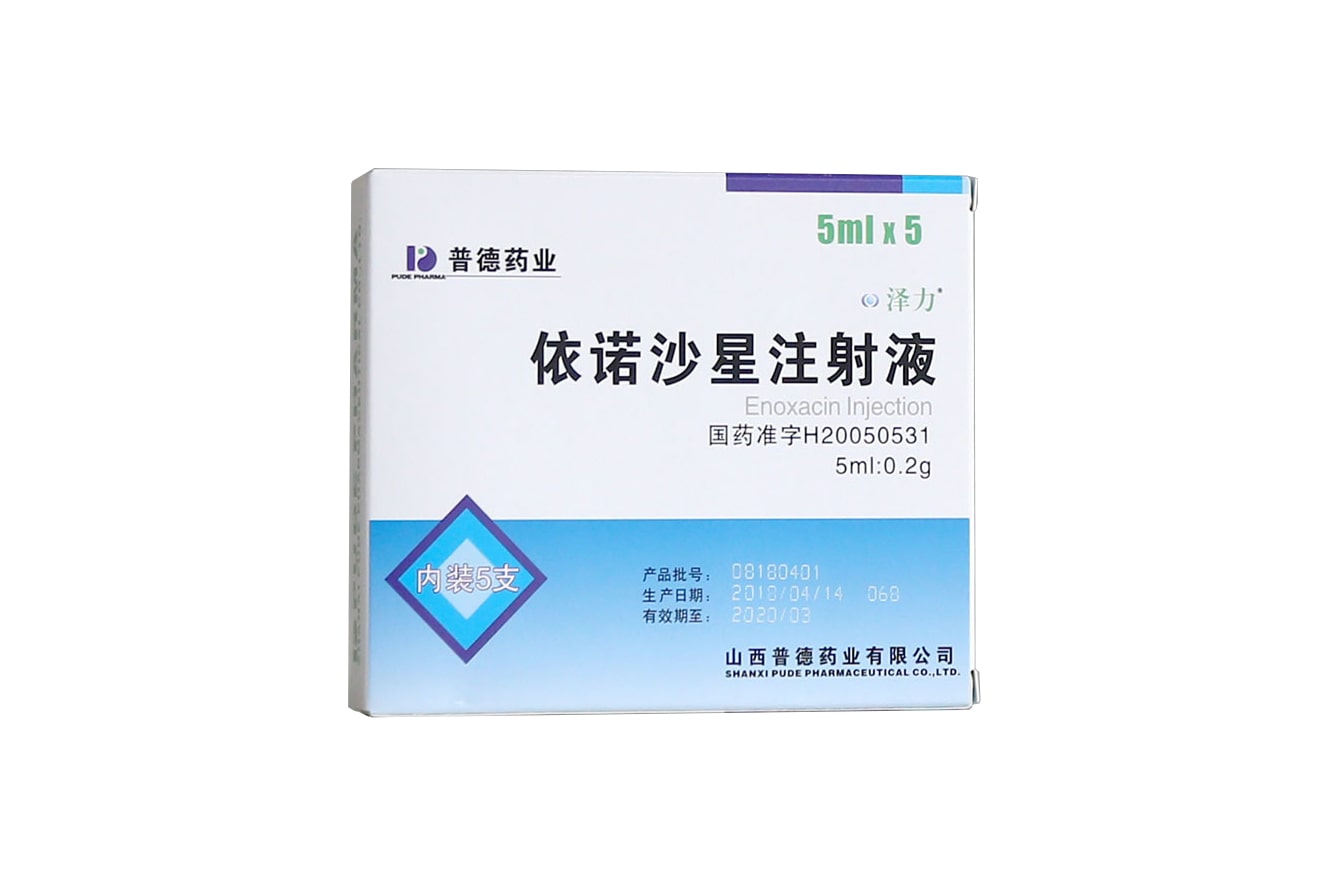



The enoxacin injection solution developed by our company is a third-generation quinolone antibiotic. It is an improved formulation based on the original enoxacin injection solution. This variety uses a new excipient instant salt formation technology, which completely solves the problem of polymeric reaction products in infusion products. Extensive pharmacological and toxicological studies have been conducted, and its quality, manufacturing process, and safety are superior to the already marketed enoxacin injection solution. Our company has applied for a patent for this new excipient. Therefore, the enoxacin injection solution developed by our company is a completely distinct and exclusive new variety from the enoxacin injection solution with glucose acid.
Packaging: 800 vials per case
Specifications: 5ml:0.2g
Shelf Life: 24 months
Approval Number: 国药准字H20050531
Indications: It is suitable for infections caused by sensitive bacteria, including: 1. Genitourinary tract infections, including uncomplicated and complicated urinary tract infections, bacterial prostatitis, Neisseria gonorrhoeae urethritis, or cervicitis (including those caused by enzyme-producing strains). 2. Respiratory tract infections, including acute exacerbations of bronchitis and pulmonary infections caused by susceptible Gram-negative rods. 3. Gastrointestinal infections caused by Shigella, Salmonella, enterotoxigenic Escherichia coli, hydrophilic aeromonads, Vibrio parahaemolyticus, and other pathogens. 4. Typhoid fever. 5. Bone and joint infections. 6. Skin and soft tissue infections. 7. Systemic infections such as sepsis.
Detail
Composition: The main component of this product is enoxacin. Its chemical name is 1-ethyl-6-fluoro-1,4-dihydro-4-oxo-7-(1-piperazinyl)-1,8-naphthyridine-3-carboxylic acid sesquihydrate.
Chemical structure:
Molecular formula: C5H17FN4O3·3/2H2O Molecular weight: 347.35
Appearance: This product is a colorless or slightly yellow clear liquid.
Indications: It is suitable for infections caused by sensitive bacteria, including:
1.Genitourinary tract infections, including uncomplicated and complicated urinary tract infections, bacterial prostatitis, Neisseria gonorrhoeae urethritis, or cervicitis (including those caused by enzyme-producing strains).
2.Respiratory tract infections, including acute exacerbations of bronchitis and pulmonary infections caused by susceptible Gram-negative rods.
3.Gastrointestinal infections caused by Shigella, Salmonella, enterotoxigenic Escherichia coli, hydrophilic aeromonads, Vibrio parahaemolyticus, and other pathogens.
4. Typhoid fever.
5. Bone and joint infections.
6. Skin and soft tissue infections.
7. Systemic infections such as sepsis.
【Specifications】 5ml: 0.2g
【Dosage and Administration】 Dissolve 0.2g in 100ml of 5% glucose injection and administer intravenously after light avoidance. Adults: 0.2g per dose, twice daily. The maximum daily dose for critically ill patients should not exceed 0.6g. The treatment duration is 7-10 days, and oral formulations can be used once significant improvement in the condition is observed during treatment.
【Adverse Reactions】
1.Gastrointestinal reactions are common and may include abdominal discomfort or pain, diarrhea, nausea, or vomiting.
2.Central nervous system reactions may include dizziness, headache, drowsiness, or insomnia.
3.Allergic reactions: rash, itching of the skin, occasionally exudative erythema multiforme and angioedema may occur. Some patients may experience photosensitivity reactions.
4.Rare occurrences include seizures, mental abnormalities, restlessness, confusion, hallucinations, and tremors. Interstitial nephritis with manifestations such as hematuria, fever, rash, etc., may occur. Venous inflammation, crystalluria (more common with high-dose administration), joint pain, facial flushing, palpitations, and chest tightness may also occur.
5.In some patients, there may be elevated serum alanine aminotransferase, increased blood urea nitrogen, and decreased white blood cell count in peripheral blood. These changes are usually mild and transient.
【Contraindications】 Contraindications include hypersensitivity to this product or fluoroquinolones, tendinitis, tendon rupture, and glucose-6-phosphate dehydrogenase deficiency.
【Precautions】
1. Currently, fluoroquinolone-resistant strains of Escherichia coli are common. A urine culture specimen should be obtained before administration to adjust the medication based on bacterial susceptibility results.
2. Crystalluria may occur with high-dose administration or when urine pH is above 7. To prevent crystalluria, it is recommended to drink plenty of water and maintain a urine output of at least 1200ml in 24 hours.
3.Dose adjustment is necessary for patients with impaired renal function based on their renal function.
4.The use of fluoroquinolones can cause moderate to severe photosensitivity reactions. Avoid excessive exposure to sunlight while using this product, and discontinue use if photosensitivity reactions occur.
5.In patients with impaired liver function, especially severe liver disease with ascites, drug clearance may be reduced, leading to increased blood drug concentration. Careful evaluation of the risks and benefits is necessary, along with dosage adjustments.
6. Patients with pre-existing central nervous system disorders such as epilepsy or a history of epilepsy should avoid using this product. If there is an indication for its use, careful consideration of the risks and benefits is necessary.
【Use in Pregnancy and Lactation】 Animal studies have not demonstrated teratogenic effects of quinolone antibiotics. However, there is no clear conclusion regarding the use of this drug in pregnant women. Considering the potential for joint lesions in immature animals, this drug is contraindicated during pregnancy, and lactating women should temporarily suspend breastfeeding when using this product.
【Use in Children】 The safety of this product in infants, young children, and adolescents under 18 years of age has not been established. It is not recommended for use in children and adolescents under 18 years of age due to the potential for joint lesions observed in several young animal species.
【Use in the Elderly】 Elderly patients often have impaired renal function, and since this product is partially excreted by the kidneys.